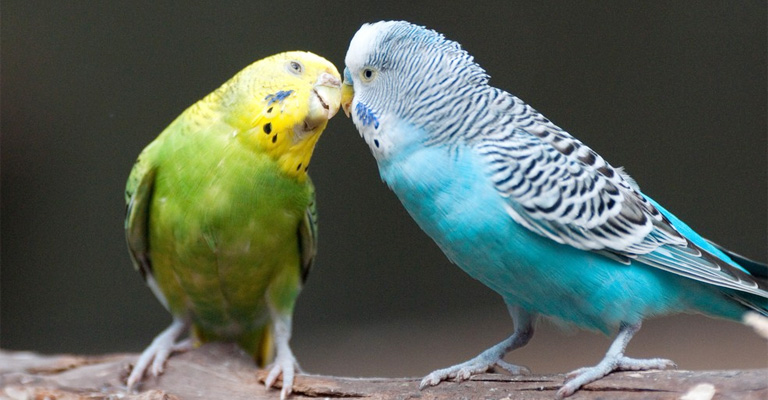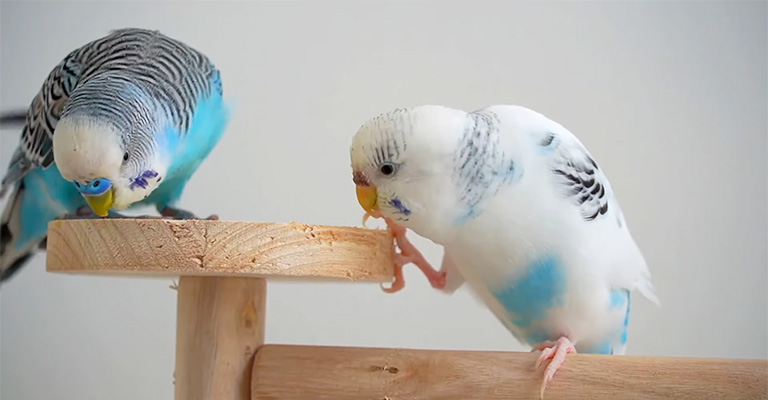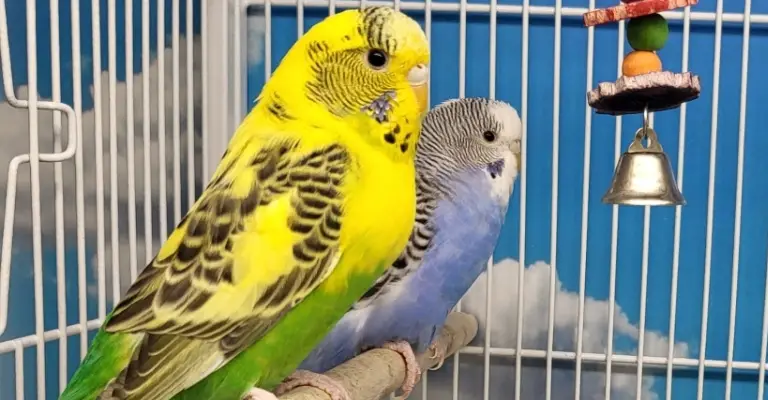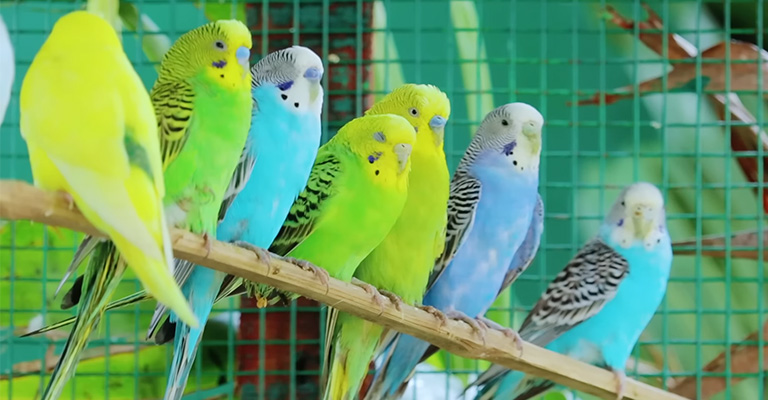The world of parakeets, these small and vibrant parrot species, is marked not only by their striking plumage and cheerful chirping but also by the intricate dynamics of their social structures.
A common question that arises among parakeet enthusiasts is whether these birds have a pecking order, a social hierarchy akin to that of many other social animals.
Do parakeets have a pecking order? The answer, in short, is yes, parakeets do have a pecking order within their flocks. This system helps establish leadership roles, allocate resources, and maintain harmony among these gregarious birds.
In this discussion, we delve into the fascinating world of parakeet behavior and the reasons behind the establishment of a pecking order among these feathered companions.
From dominance displays to age and experience factors, we explore the mechanisms that shape this avian hierarchy and the implications for those who share their lives with these beloved pets.

Do Parakeets Have a Pecking Order?
Yes, parakeets, also known as budgerigars or budgies, do establish a pecking order within their flocks or social groups. This pecking order is more commonly observed in larger groups of budgies rather than in pairs or small clusters.
Within a group, parakeets will establish a hierarchy based on dominance and social structure. The more dominant birds will often assert their authority by displacing or pecking at subordinate birds, particularly during feeding or perching on favored spots.
However, it’s essential to note that aggression in budgie flocks is generally not as pronounced as in some other parrot species, and they often resolve disputes with displays and vocalizations rather than aggressive physical interactions.
Understanding and respecting the pecking order in a multi-budgie setup is crucial for keeping them harmonious and stress-free.
Why Would Parakeets Have A Pecking Order?

Parakeets, like many social birds, establish a pecking order within their flocks for several reasons, which help maintain harmony and order within their group. Here are some explanations:
Resource Access
In the wild, food and water sources can be limited. Establishing a pecking order allows dominant birds to have priority access to these resources, ensuring their survival. Subordinate birds wait their turn and adapt to different times for feeding.
Breeding Rights
Dominant parakeets often have mating privileges, allowing them to pass on their genetic traits. This hierarchy helps maintain genetic diversity within the flock while ensuring the fittest birds reproduce.
Social Structure
A clear pecking order defines the roles and responsibilities of each bird within the group. This structure helps minimize conflicts and promotes cooperation during activities such as nest-building and chick-rearing.
Security
The hierarchy enhances the flock’s overall security. Dominant birds often serve as sentinels, warning the group of potential threats, while subordinate birds focus on other tasks like foraging or incubating eggs.
Territorial Defense
Maintaining a pecking order aids in protecting the flock’s territory. Dominant birds often play a more active role in defending the group’s nesting and feeding areas, reducing the risk of territorial disputes.
Communication and Bonding
Interactions within the pecking order involve various vocalizations, displays, and physical contact. This communication and bonding are essential for social cohesion, reducing tension and aggression.
Survival of the Fittest
The pecking order ensures that the fittest and healthiest birds have priority access to resources and breeding rights. This natural selection process helps improve the overall fitness of the flock, increasing its chances of survival.
Understanding the reasons behind the pecking order in parakeet flocks can help bird enthusiasts create enriching and stress-free environments for their feathered friends while respecting their natural social dynamics.
How Would A Pecking Order Be Decided?

A pecking order in a social group of birds is typically established through various mechanisms and interactions. Here are some systems by which a pecking order can be decided:
Dominance-Based Hierarchy
The dominant bird is usually the most assertive and confident member of the group. It may use physical displays, vocalizations, and, occasionally, pecks to establish and maintain its status.
Subordinate birds recognize this dominance and yield to the more dominant bird’s demands.
Age and Experience
Older and more experienced birds often take on a dominant role. Younger or less experienced birds may defer to their elders, as the older birds have learned the ropes of survival and are more adept at acquiring resources.
Physical Strength and Size
In some cases, the larger and stronger birds may naturally dominate smaller, weaker individuals. Physical attributes can play a significant role in determining the pecking order, particularly in species where size matters.
Nesting and Breeding Rights
Breeding pairs usually have elevated status within a group. They may assert dominance over other birds during the breeding season to secure resources for their offspring and to ensure the survival of their genetic lineage.
Resource Control
Birds that have priority access to food, water, or prime nesting sites may gain higher status within the group. They use these resources as leverage to establish dominance and maintain their position in the pecking order.
Hierarchical Displays
Birds employ a range of displays, such as puffing up their feathers, vocalizations, and body language, to communicate their intentions and assert their rank. These displays help in avoiding physical conflicts.
Social Learning
Younger or newer members of a group may learn the social hierarchy by observing interactions between established members. Through these observations, they quickly grasp their place in the pecking order and understand how to behave within the group.
The establishment of a pecking order is not solely based on one system but often involves a combination of these mechanisms. The specifics can vary depending on the species, the environment, and the individual personalities of the birds within the group.
How Do Parakeets Decide The Leader?

Parakeets establish a leader or pecking order within their flock through various mechanisms and interactions. Here are some ways in which parakeets decide the leader:
Dominance Displays
Dominance in a parakeet flock is typically determined through physical displays and behaviors. The parakeet that exhibits the most assertive and dominant actions, such as head bobbing, raising feathers, and making louder vocalizations, often assumes a leadership role.
These displays help establish their authority and influence within the group.
Physical Size and Strength
Larger and stronger parakeets may naturally assume leadership positions. Their physical attributes can give them an advantage in securing prime access to resources, perches, and nesting sites, reinforcing their dominant status.
Age and Experience
Older parakeets tend to assert dominance over younger, less experienced flock members. Their accumulated knowledge of foraging, avoiding predators, and choosing safe roosting spots contributes to their authoritative role.
Mating Pairs
Breeding pairs within the flock often hold a leadership role. They can maintain dominance during the breeding season, as they require specific resources to ensure the survival of their young. Other flock members may respect this hierarchical arrangement.
Resource Control
The parakeet that effectively controls access to vital resources, such as food and water, can become the leader. They determine when and where the flock feeds, often setting the pace for the rest of the group.
Territorial Defense
Parakeets may assert leadership when defending their territory or preferred nesting locations. Dominant birds actively protect these areas, and their willingness to confront intruders reinforces their role as leaders.
Social Learning
Young or new members of the flock often learn the social hierarchy by observing the behavior of established leaders. This helps them understand the expected behaviors within the group and adjust their actions accordingly.
The decision on who becomes the leader is influenced by a combination of these factors, with the parakeet that exhibits the most dominant traits and effectively manages resources typically taking the lead.
The specific dynamics can vary among flocks, and not all flocks have a single, clearly defined leader.
FAQs
Do parakeets have a pecking order?
Yes, parakeets do establish a pecking order within their flocks. This hierarchy helps define leadership roles, allocate resources, and maintain social harmony among these gregarious birds.
How is the pecking order determined among parakeets?
The pecking order in parakeets is determined through various mechanisms, including dominance displays, physical attributes like size and strength, age and experience, breeding roles, resource control, territorial defense, and social learning. Why is a pecking order important for parakeets?
The pecking order is essential for parakeets as it aids in resource allocation, minimizes conflicts, and enhances cooperation within the flock. It ensures that each bird has access to vital resources and maintains order, reducing stress and promoting overall well-being.
Can parakeet owners observe the pecking order of their pets?
Yes, parakeet owners can observe the pecking order within their pet flocks. Dominance displays, interactions during feeding, perching choices, and overall behaviors provide clues to the hierarchy.
Does the pecking order change over time among parakeets?
The pecking order among parakeets can evolve, particularly with changes in the flock composition or the introduction of new members. Dominance roles may shift based on individual interactions and circumstances, leading to adjustments in the hierarchy over time.
Conclusion
The existence of a pecking order among parakeets serves as a testament to the complex social dynamics within these avian communities.
The pecking order helps allocate resources, maintain order, and minimize conflicts, contributing to the overall well-being of the flock.
Dominance displays, physical attributes, and social learning play crucial roles in determining leadership positions within the group.
Understanding the intricacies of this hierarchy can help parakeet enthusiasts create enriching and stress-free environments for their feathered friends.
By respecting the natural social dynamics of parakeets and providing a stimulating and supportive habitat, bird owners can ensure the happiness and harmony of their sociable and intelligent companions.